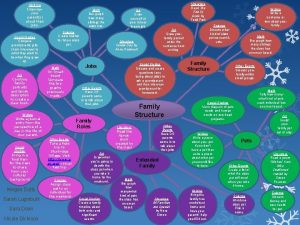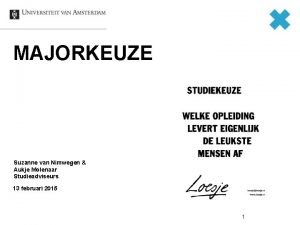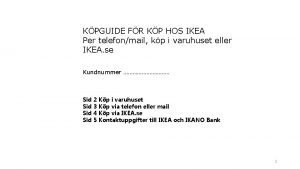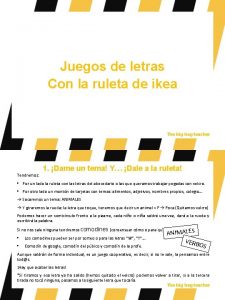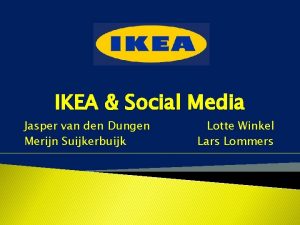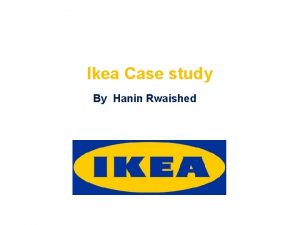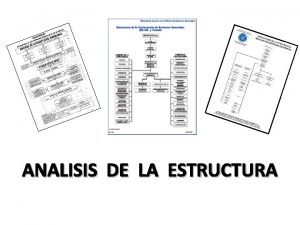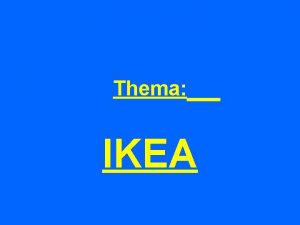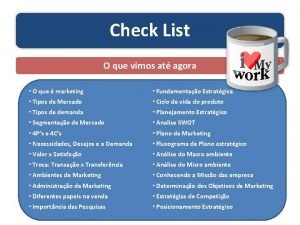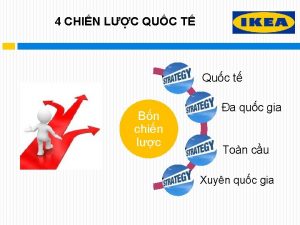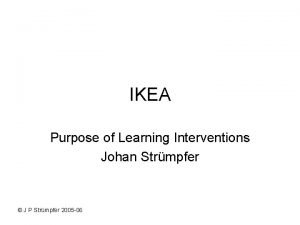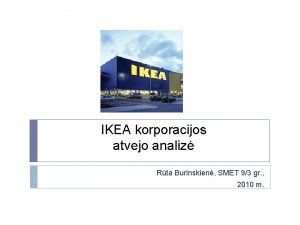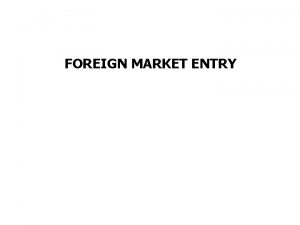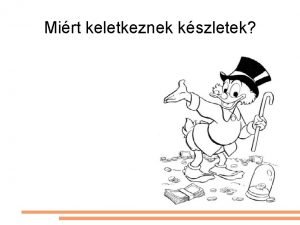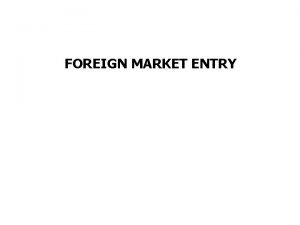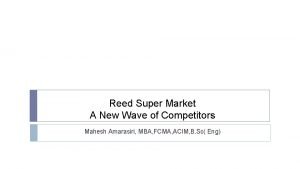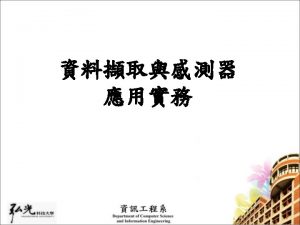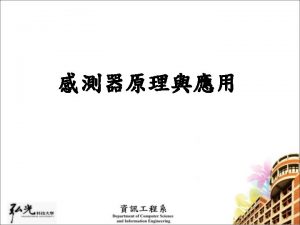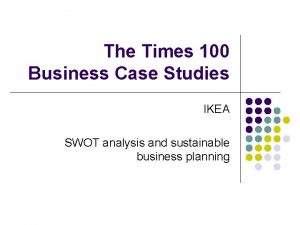IKEA Case Study Matt Mc Inerney Colin Reed
















































- Slides: 48

IKEA Case Study Matt Mc. Inerney, Colin Reed, Bryce Doubrava, Andrew Graczyk, & Mark Wylie Marketing Strategy MKTG 476 3. 17. 15




Problem Statement with Evidence • Problem Tree

Problem Tree

Position Statement IKEA locations more readily accessible to the target market could § Increase market share § Increase sales /profitability § Decrease number of competitors entering the market Case Alternatives: • Satellite stores • Push Online Sales

Situation Analysis • Company • Industry • Value chain • Porter’s Five Forces

Situation Analysis Company • Mission • Corporate Culture • Growth Rate of Industry • Relative Market Share

Situation Analysis Company - Mission • Mission • To create a better everyday life for many people by providing a wide range of welldesigned, functional home furnishing products at prices so low that as many people as possible will be able to afford them.

Situation Analysis Company – Corporate Culture Based on shared values • Togetherness – first name basis • Cost-consciousness – no flying first class • Respect – respect employee’s ideas, needs, ambitions, and capabilities • Diversity – diverse work force

Situation Analysis Company – Company Analysis • Low cost defender • Produces products at low cost to sell at low prices • Sells tasteful and cleverly designed products to the masses • Selling high volume of furniture products at low prices • Flat packaging – products assembled at home and low transportation costs • No significant investment in research and development • Little customer service • Backward vertical integration – manufactures some of own products • Many suppliers – good bargaining power with suppliers/lower cost

Situation Analysis Company – Industry Growth Rate Furniture Industry Growth Rate (Market. Line, 2014) • 3. 2% global industry growth rate

Situation Analysis Company – IKEA Market Share IKEA Global Market Share of Furniture Industry • 8. 0 % global industry market share (B. Stone, Market. Line Communication, 2/12/15)

Situation Analysis How the Industry Works

Situation Analysis Value Chain Michael Porter • Introduced value chain concept • Identifies activities through which firms can create value and a competitive edge • Primary Activities and Support Activities

Situation Analysis IKEA Value Chain Primary Activities – Inbound Logistics • Distribution of products to stores from 32 distribution centers located in 16 countries (Annual Report, 2013) • 11 customer distribution centers (Market. Line, 2014) • IKEA has 1046 home furnishing suppliers located in 52 countries. (Market. Line, 2014)

Situation Analysis IKEA Value Chain Primary Activities – Operations • Operations are conducted in four divisions Franchise, retail, property, and finance • Operations in more than 38 countries; 208 company operated stores in 26 countries, remaining stores are franchises • IKEA through vertical integration manufactures goods through its wholly owned manufacturing subsidiary, Swedwood (Marketline, 2013). • 44 production units globally manufacture products for IKEA (Annual Report, 2013) • Flat packaging

Situation Analysis IKEA Value Chain Primary Activities – Outbound Logistics • Transportation of products is done by customers • 211 million copies of IKEA catalogues were printed in 29 languages in 2013 (Statista, 2013). • Catalogue app was downloaded 9. 7 million times in 2013 (Statista, 2013)

Situation Analysis IKEA Value Chain Primary Activities – Marketing & Sales Selling products in 303 IKEA Group stores located in 26 countries (Annual Report, 2013) Target market is focused on families, students, and singles with middle to lower incomes Low cost defender marketing strategy Family friendly store environments Integrated marketing communication message focuses on cost advantage competitive edge • IKEA Corporate Social Responsibility programs include 100% paper pallet use, operation of wind turbines and regular donations to Save the Children and UNISEF charities (Dudovskiy, 2014); IKEA currently has investments in wind projects in eight countries (with a total of 206 turbines) as well as 550, 0000 solar panels (Kelly-Detwiler, 2014) • • •

Situation Analysis IKEA Value Chain Primary Activities – Services • Very limited level of customer service is provided • Information to customers through use of catalogues and displays • Low number of sales associates in stores • Restaurants and child care provided at retail outlets • Kitchen planning, office planning, bedroom, and living room planning through free 3 D software (IKEA, 2015 a) • Offers customers interest free financing (IKEA, 2015)

Situation Analysis IKEA Value Chain Secondary Activities – Firm Infrastructure Hierarchical organizational structure Public Affairs – Press Releases, Product Recalls IKEA Supplier Quality Assurance IKEA of Sweden Älmhult, Test laboratory • Product testing during product development to assure safe and healthy IKEA products (Jobett, 2015) • Finance Division to manage financial assets and group liquidity (Inter-IKEA, 2012) • •

Situation Analysis IKEA Value Chain Secondary Activities - Human Resources Management • • • High level of commitment to HR practices Effective staff training and development programs Concerned with gender balance in leadership positions Bonus incentives for employees to reach goals Recruitment in every country where IKEA has markets

Situation Analysis IKEA Value Chain Secondary Activities – Technology Development • Research and development activities are initiated in Sweden • Extensive use of information technology in business processes

Situation Analysis IKEA Value Chain Secondary Activities – Procurement • Wholly owned subsidiaries procure raw materials primarily for the manufacture of wood furniture (Market. Line, 2014). • Long-term strategic relationships with suppliers (Market. Line, 2014)

Situation Analysis Porter’s Five Forces Analysis • One way to assess and explain long-term attractiveness and profitability of an industry • Five Forces • Threat of New Entrants • Bargaining Power of Suppliers • Bargaining Power of Buyers • Threat of Substitute Products • Rivalry Among Existing Competitors

Situation Analysis Porter’s Five Forces Analysis - Threat of New Entrants Suppliers • IKEA has long term relationship with suppliers • IKEA has competitive edge over new entrants due to economies of scale Low Cost Switching • Buyers are likely to stay with IKEA in spite of low cost switching • IKEA has 8% of the global market share • Strong brand image Overall Threat of New Entrants • Industry is moderate • IKEA - the threat of new entrants is likely to be less

Situation Analysis Porter’s Five Forces Analysis- Bargaining Power of Suppliers • Backward integration reduces power of suppliers because supplier is owned by manufacturer or retailer • Large number of suppliers decreases supplier bargaining power • Long term supplier relationship decreases supplier bargaining power Bargaining power of suppliers • Furniture Industry – Moderate • IKEA – backward integration, 1046 suppliers, long term supplier relationships • less than moderate bargaining power of suppliers for IKEA

Situation Analysis Porter’s Five Forces Analysis- Bargaining Power of Buyers • Large number of buyers makes buyer’s bargaining power less • Low cost switching of buyers strengthens the bargaining power of the buyer Bargaining power of buyers • Furniture Industry – Moderate • IKEA – large customer base; brand loyalty; low cost • less than moderate bargaining power of buyers for IKEA

Situation Analysis Porter’s Five Forces Analysis- Threat of Substitute Products • Cheap Alternatives • Low Cost Switching IKEA • Brand image, size, and low cost/price make threat of substitute products less • Price of IKEA products are in line with cheap alternatives making threat of substitute products less Furniture Industry – Moderate threat of substitute products IKEA – less than moderate threat of substitute products

Situation Analysis Porter’s Five Forces Analysis- Rivalry Among Existing Competitors • Competitor Size – large competitors benefit from economies of scale • Low market growth – makes competition intense as firms compete for the same share of the market IKEA • Large company – benefits from economies of scale and less supplier bargaining power making it more competitive Furniture Industry – Moderate threat of rivalry IKEA – moderate to less moderate threat of rivalry

Designing Marketing Strategy • • Customer targeting strategies Customer positioning strategies Market research Customer Relationship Management

Designing Marketing Strategy Market Segmentation • • Low/middle income young singles, college students, or young couples Suburban dwellers Important subgroups • • 80 million Baby boomers Gen. X & Millennials Persona • • • 18 to 34 year olds and 35 to 49 year olds Unisex approach targeting both genders Young low/middle income singles, college students, couples $15, 000 to $50, 000 annual salary Uses computers, smart phones, other electronic devices Eco- friendly

Designing Marketing Strategy Customer Targeting Strategies • Requires knowledge of • Customer needs • Decision making process • How customer searches for information on a product

Designing Marketing Strategy Customer Needs Analysis for the IKEA customer • Low priced functional products • Wide range of product choices • Products easy to transport and assemble • Positive shopping experience • Average quality products • Products that create a positive social environment and reflect their tastes and personality

Designing Marketing Strategy Customer Decision Making Process • • • Problem Recognition Information Search • Internal Search – information from memory • External Search- information from outside sources • Important for IKEA to be near target market so that when they are conducting a search IKEA products are close at hand. Problem Resolution • Evaluate alternatives to solve the problem • Select best alternative

Designing Marketing Strategy IKEA Customer Positioning Strategy • Customer positioning map • Value association map • Typologies

Designing Marketing Strategy IKEA Customer Positioning Strategy • Customer positioning map

Designing Marketing Strategy IKEA Customer Positioning Strategy • Value Association Map

Designing Marketing Strategy IKEA Customer Positioning Strategy • IKEA Typologies • Neilson Prizm • Examines segment groups based on demographics and behaviors that will help IKEA identify, reach, and retain their most profitable customers. • Two major Neilson segments that match IKEA’s segment • Boomtown Singles • City Startups.

Designing Marketing Strategy IKEA Customer Positioning Strategy IKEA Typology – Boomtown Singles: Urbanicity: Second City Income: Lower Mid Income Producing Assets: Below Avg. Age Ranges: <55 Homeownership: Mix, Renters Employment Level: WC, Service, Mix Education Level: College Grad. Ethnic Diversity: White, Black, Hispanic, Mix

Designing Marketing Strategy IKEA Customer Positioning Strategy IKEA Typology – City Startups: Urbanicity: Second City Income: Lower Mid Income Producing Assets: Low Age Ranges: <55 Homeownership: Renters Employment Level: WC, Service, Mix Education Level: Some College. Ethnic Diversity: White, Black, Hispanic, Mix

Designing Marketing Strategy IKEA Market Research – Survey • To gain information on two proposed IKEA sales alternatives, satellite stores and an aggressive push towards online sales marketing research can be • A survey could be conducted to • collect consumer information on each alternative • to gain insight as to consumer interest in these alternatives • Gauge each alternative’s likelihood of success.

Designing Marketing Strategy IKEA Market Research – Survey

Designing Marketing Strategy Customer Relationship Management • Monitor and assess the relationship between a business and its customers • Develop a comprehensive view of the customer at every point of contact with the company • Four systems are used to track customers • Internal recording systems • Provide data on sales…what is selling and what is not • Marketing databases • Used to manage marketing campaigns • Record demographics, detailed transactions, etc. • Competitive intelligence systems • Collect and analyze data about the firm’s competitors • Client contact and sales force automation systems • Help salespeople keep track of customer names, addresses, phone numbers, etc.

Designing Marketing Strategy Marketing Program Development • Marketing mix across alternatives plus status quo

Designing Marketing Strategy Status Quo Satellite stores Online Stores (More) Product: The marketer must shape each of the following strategies into a coordinated plan of action in order to be effective. No changes – Low quality materials with functionality, moderate durability, “Democratic design” assembly required , Flat-packaged boxes for easy delivery No change in design. Select product type accordingly, based on overall style popularity, and what type of satellite store we are dealing with. Offer all product types. Easy delivery Price: The marketer must choose the role of price in his positioning strategy, including the desired positioning of the product or brand as well as the margin necessary to satisfy and motivate distribution channel participants. No changes – “Low price with meaning. ” Pragmatic, cost cutting. . 10%-15% markup from price in IKEA store. 10%-15% markup from IKEA store. Still low price and very competitive. Motivates customer to visit. Place: The marketer needs to decide the type of channel organization to use, the extent of channel management, and the intensity of distribution appropriate for his product. No changes - Self-service, Promotion No changes- commitmentfree approach to buying furniture. The marketer must choose activities, such as advertising, sales promotion, sales force, direct marketing, and public relations that perform an essential role in communicating the strategy to buyers. Child care facility, IKEA in-store restaurant It is just furniture, change it. TV commercials/ traditional advertising. More opportunity to motivate participants. Motivates consumer to visit the real IKEA. Smaller stores to cover more area. Specific IKEA section taking up small section of store. Create more online web pages for selling products. Social media, Blogs. Incentives to visit real Advertise more towards IKEA- Coupons, the electronic audience, Information on locations Facebook advertisements, and what to expect from E-Mailing lists that offer the IKEA experience. “online only” specials. exposure through satellite stores advertising.

Designing Marketing Strategy Evaluation of Alternatives Across Critical Factors and Key Performance Indicators Performance Measure Shorter Time to Implement Weight Status Quo Score Status Quo Value Online Store Score Online Store Value Satellite Store Score Satellite Store Value 5% 30 1. 5 50 2. 5 45 2. 25 30% 30 9 80 24 75 22. 5 30% 50 15 40 12 45 13. 5 15% 30 4. 5 60 9 55 8. 25 10% 40 4 20 2 30 3 10% 50 5 20 2 90 9 100% 39 More Convenient Location Higher Customer Satisfaction Affordable Cost to Implement Overall Risk Cost of Return Total Score 51. 5 58. 5
 Reed v reed ap gov
Reed v reed ap gov Best worst and average case
Best worst and average case Crm failure case study
Crm failure case study Grandparent interview ikea
Grandparent interview ikea Central place theory definition
Central place theory definition Corporate culture ikea
Corporate culture ikea Ikea nimwegen
Ikea nimwegen Ikea kundnummer
Ikea kundnummer Ruleta ikea letras
Ruleta ikea letras Lucy slinger ikea
Lucy slinger ikea Supply chain of ikea
Supply chain of ikea Inter ikea systems bv 2017
Inter ikea systems bv 2017 Siemon ariens en lars van den dungen
Siemon ariens en lars van den dungen Ikea crisis management
Ikea crisis management Ikea market share by country
Ikea market share by country Ikea advantages
Ikea advantages Lana harfouche
Lana harfouche Sistema del valore
Sistema del valore Ikea perth
Ikea perth Estructura del analisis
Estructura del analisis Ikea cancer
Ikea cancer Ikea liikeidea
Ikea liikeidea Ouverture ikea bayonne
Ouverture ikea bayonne Ikea pestle analysis
Ikea pestle analysis Approccio al cliente
Approccio al cliente Ikea
Ikea Woher kommt der name ikea
Woher kommt der name ikea Ikea
Ikea Lorenz isler
Lorenz isler Httpswww.youtube.comwatchvdqw4w9wgxcq
Httpswww.youtube.comwatchvdqw4w9wgxcq Analise swot ikea
Analise swot ikea Ikea sustainability goals
Ikea sustainability goals Chiến lược xuyên quốc gia của ikea
Chiến lược xuyên quốc gia của ikea Ikea flat roof system drain
Ikea flat roof system drain Ikea
Ikea Ikea pagrindinė organizacija
Ikea pagrindinė organizacija Zakld
Zakld Market entry barriers
Market entry barriers Integracion hacia adelante
Integracion hacia adelante Cas ikea management
Cas ikea management Csillapításos modell
Csillapításos modell Lämmön siirtyminen
Lämmön siirtyminen Idya ikea
Idya ikea Clarinet chalumeau register
Clarinet chalumeau register Tina redse
Tina redse Reed vs king
Reed vs king Oki reed switch
Oki reed switch Reed supermarkets: a new wave of competitors
Reed supermarkets: a new wave of competitors Ees elsevier
Ees elsevier



